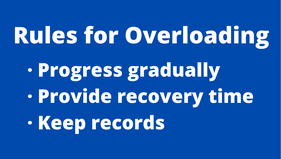
Strength is a major key to canine health and longevity. A dog with strong muscles is less likely to suffer injuries, both acute injuries and chronic injuries such as arthritis, which is one of the most common conditions in senior and geriatric dogs. And of course, for those of you who enjoy training and competing with your dogs, strength is strongly correlated with speed, which is a component of many dog sports.
The overload principle is one of the major concepts of strength training (1). Simply put, it says that if you want to improve your dog’s strength, you must progressively increase the total work that your dog’s muscles do.
What do we mean by Total work? Total Work is a combination of the frequency, duration, and intensity that your dog experiences.
Reps and Sets are Secondary
If you have ever worked out with a personal trainer, you have noticed that he or she will tell you to repeat an exercise a certain number of times. For example, let’s say you are performing biceps curls to strengthen your biceps muscle. Your trainer might ask you to lift a 12-lb dumbbell 10 times. These are repetitions, which are called “reps.” After a brief rest period, your trainer then tells you do perform another group of reps – perhaps 8 biceps curls with a 15-lb dumbbell. Each of those groups of reps is called a “set.”
Now, what you might not notice is that your trainer is carefully watching you and determining how many more reps of a specific weight will cause you to be unable to continue with the reps near the end of a second or third set. That’s overload – when the muscles can no longer complete the exercise. Your trainer knows that overload is necessary to build strength.
An important concept of overload is that it should occur near the end of a period of progressively increasing total work. Continuing with the example of performing biceps curls, if your trainer asked you to do 100 reps with a 1-lb dumbbell, you are unlikely to go into overload at all. On the other hand, if he or she asks you to do biceps curls with a 30-lb dumbbell, you might be unable to do even one curl1 Neither of those two scenarios will help strengthen your biceps.
As you can see from this example, the concept of overload is primary. Reps and sets are only used as a means to progressively increase the total work performed by the muscles. Because each dog is an individual, there can be no standing rule regarding the number of reps or sets that your dog should perform for any given exercise. The number of reps or sets is determined on an individual basis for each dog as a way to work progressively to overload.
How to Recognize Overload in Your Dog
When you are going into overload while exercising, your muscles might shake, you might grimace, and eventually you will fail to be able to perform the exercise. The signs of overload in dogs are similar, though often more subtle, and include:
Watch your dog carefully and you will soon learn its individual signs of overload. Furthermore, different exercises might induce different signs of overload. For example, when practicing having your dog sit on its haunches to improve core strength, when approaching overload, your dog might fall to one side or put its front feet down. On the other hand, when you are working on diagonal leg lifts, another core strength exercise, overload is usually indicated by excessive fidgeting, or the dog just sitting down. Part of the fun of working strength exercises with your dog involves getting to know what overload looks like for your individual dog for any given exercise.
Rules for Gradual and Safe Overloading
1. Always progress gradually. It is better to take longer to build strength than to risk an injury.
2. Provide recovery time. Never strength train the same set of muscles two days in a row. Leave 48 hours for the muscles to recover. This will prevent overtraining, which can lead to injuries.
3. Keep a log of training sessions, indicating the frequency, duration and intensity of the exercises you are asking your dog to perform. In addition, make a note of your dog’s behavior as it went into overload. That should help you recognize overload in the future so you can stop when overload occurs and not push your dog so hard that you potentially cause injury. Finally, note your dog’s reactions to working to overload. Did your dog seem sore later? Was he or she extra tired? If so, you should back off on how hard you push to overload.

Exceptions to the Overload Principle
Geriatric dogs need to be exercised very carefully to prevent injury and maintain joy and motivation. While it is still useful to work these dogs to gentle overload, the signs of overload can be very subtle in them. If you have any indication at all that your dog is resisting the exercise, stop and rethink how you are performing the exercise and reevaluate whether your dog might be experiencing pain, such as that due to arthritis, rather than overload.
Puppies under 6 months of age should not be strength trained. And between 6 months and the age of growth plate closure (usually 12 to 14 months), puppies should only be gently strength-trained. Watch for the very earliest signs of overload and stop then. Puppy bodies are growing rapidly and changing shape and proportion. Let that growth and development happen without excessive emphasis on gaining muscular strength.